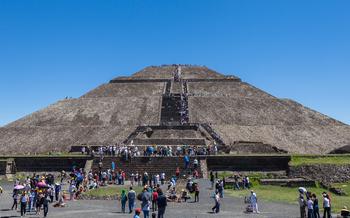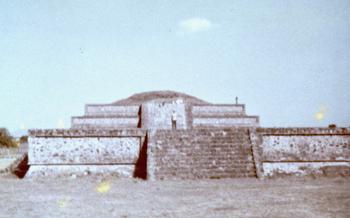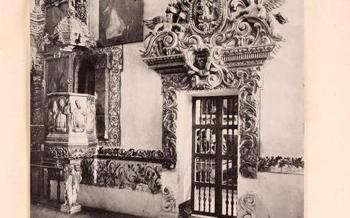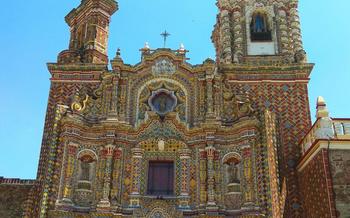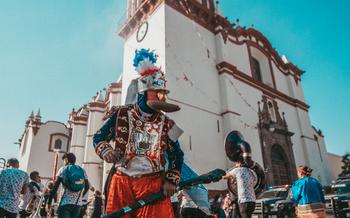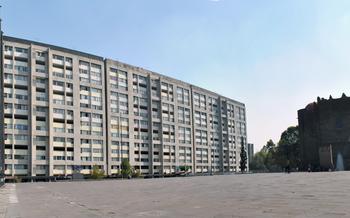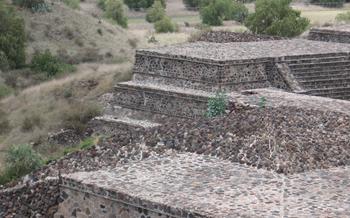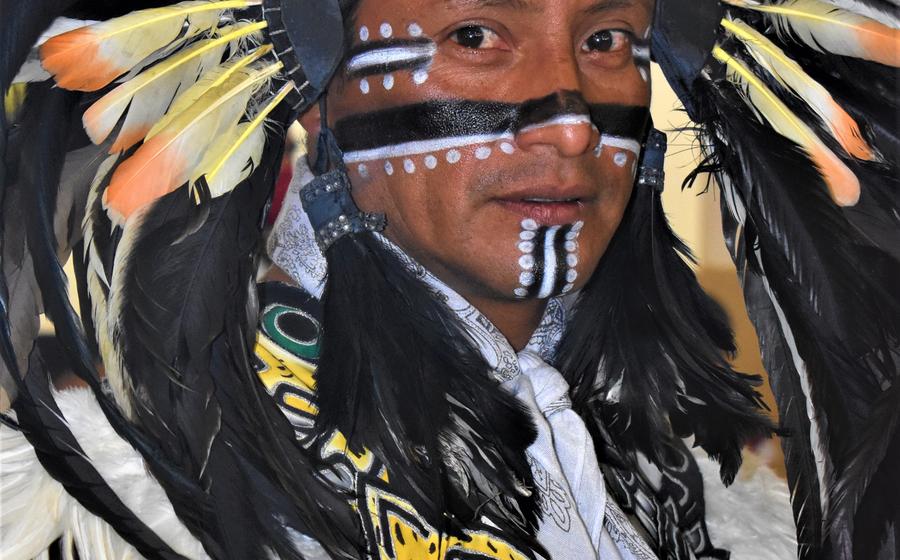
Ixmiquilpan Convent
- A Monumental City in the Highlands
- Exploring the Past: A Journey to Teotihuacan
- Ixmiquilpan Convent: A Haven of History
- Step into the Past: Unraveling the Monastery's History
- Marvels of Architecture: Exploring the Convent's Design
- Exploring the Interiors: A Journey Through Time
- A Tapestry of Art: Murals and Paintings
- Sacred Spaces: The Altars and Chapels
- The Convent Courtyard: A Place of Peace and Reflection
- Unveiling the Mysteries: The Convent's Archaeological Discoveries
- A Living Legacy: The Convent's Role Today
- Experiencing the Convent: A Visitor's Guide
- Unforgettable Moments: Personal Anecdotes and Reflections
- Beyond the Convent: Exploring Teotihuacan's Treasures
- Insider Tip: Unveiling the Hidden Gem
A Monumental City in the Highlands
In the heart of Mexico, nestled amidst the awe-inspiring landscapes of the highlands, lies the ancient city of Teotihuacan. This monumental metropolis, once a thriving center of Mesoamerican civilization, stands as a testament to the ingenuity and architectural prowess of its creators. Its historical significance and archaeological importance have earned it a prominent place among the world's most renowned cultural landmarks.
Easily accessible from Mexico City, Teotihuacan beckons history buffs, culture enthusiasts, and travelers alike to embark on a journey through time, unraveling the mysteries of a civilization that left an indelible mark on Mexican heritage. Among its many wonders, the Ixmiquilpan Convent stands as a testament to the enduring legacy of the Franciscan missionaries who arrived in these lands, blending their faith with the rich cultural tapestry of Teotihuacan.
Exploring the Past: A Journey to Teotihuacan
Teotihuacan, a city shrouded in mystery and wonder, beckons travelers to embark on a journey through time. This ancient metropolis, once home to a thriving civilization, has captivated the world with its awe-inspiring pyramids, majestic temples, and enigmatic history. As you wander through the archaeological site, you'll feel the weight of centuries upon your shoulders, transported back to a time when gods and mortals walked hand in hand.
The Teotihuacans, a Mesoamerican people, built this city between 100 BC and 700 AD. Their advanced knowledge of astronomy, engineering, and agriculture allowed them to create a sophisticated society that left an indelible mark on history. Teotihuacan's influence extended far beyond its borders, reaching as far as the Maya and Zapotec civilizations.
The city's cultural significance cannot be overstated. Teotihuacan was a religious, economic, and political hub, where people from different regions came to trade, worship, and celebrate. Its legacy lives on in the traditions and beliefs of modern-day Mexico, a testament to its enduring impact on Mexican heritage.
Ixmiquilpan Convent: A Haven of History
Nestled within the archaeological zone of Teotihuacan, the Ixmiquilpan Convent stands as a testament to the region's rich history and cultural heritage. Constructed in the 16th century by Franciscan missionaries, the convent served as a central hub for the evangelization of the indigenous population. Its strategic location amidst the ancient city's ruins allowed the missionaries to establish a strong foothold in the area and spread Christianity among the native communities. Over the centuries, the convent has undergone several transformations and renovations, adapting to the changing needs of the community while preserving its architectural integrity and historical significance. Today, the Ixmiquilpan Convent is a symbol of Teotihuacan's enduring legacy, inviting visitors to delve into the depths of its history and explore the captivating stories that its walls hold.
Step into the Past: Unraveling the Monastery's History
The Ixmiquilpan Convent, a testament to the fusion of Spanish and indigenous cultures, owes its existence to the tireless efforts of Franciscan missionaries. Driven by their unwavering faith and a burning desire to spread Christianity, they embarked on a mission to establish a religious stronghold in the heart of Teotihuacan. With unwavering determination, they laid the foundation stone in 1540, marking the beginning of a remarkable journey of faith and devotion.
Over the ensuing decades, the convent gradually took shape, its walls rising steadily towards the heavens. Skilled craftsmen, blending their traditional techniques with European influences, meticulously carved intricate designs into the stone, leaving an enduring legacy of artistry and craftsmanship. By 1560, the edifice stood in all its glory, a symbol of the enduring spirit of the Franciscan order and a beacon of hope for the indigenous communities they sought to serve.
Playing a pivotal role in the evangelization of the region, the Ixmiquilpan Convent became a center for religious instruction and cultural exchange. Within its hallowed walls, indigenous peoples embraced the teachings of Christianity, while missionaries immersed themselves in the customs and traditions of the native inhabitants. This reciprocal exchange fostered mutual understanding and laid the groundwork for a harmonious coexistence between two distinct cultures.
Throughout the centuries, the convent has undergone meticulous restoration efforts, ensuring its preservation for generations to come. Dedicated teams of experts have painstakingly restored crumbling facades, reinforced aging structures, and breathed new life into the vibrant murals that adorn its walls. Their unwavering commitment has ensured that this architectural masterpiece continues to stand as a testament to the indomitable spirit of the Franciscan missionaries and the enduring legacy of their mission in Teotihuacan.
Marvels of Architecture: Exploring the Convent's Design
The Ixmiquilpan Convent stands as a testament to the architectural prowess of the Franciscan missionaries. Its unique features blend elements of Gothic, Renaissance, and indigenous styles, creating a harmonious fusion of European and Mesoamerican influences. The main church, with its vaulted ceilings and intricate rib vaulting, is a masterpiece of Gothic architecture. The cloisters, with their graceful arches and delicate tracery, showcase the elegance of the Renaissance style. The use of local materials, such as volcanic stone and adobe, adds a touch of authenticity and connects the convent to its surroundings.
The convent's design is rich in symbolism and iconography. The main portal, with its elaborate carvings depicting biblical scenes, invites visitors to enter a sacred space. The interior walls are adorned with murals and paintings that depict the lives of saints and religious figures, serving as visual reminders of the convent's religious mission. The convent's strategic location atop a hill reinforces its symbolic significance as a beacon of faith and spirituality.
The Ixmiquilpan Convent has undergone several renovations and restoration projects over the centuries, ensuring its preservation for future generations. These efforts have focused on maintaining the convent's original architectural integrity while respecting its historical significance. As a result, the convent remains a stunning example of 16th-century architecture, blending artistic influences from both sides of the Atlantic.
Exploring the Interiors: A Journey Through Time
Step inside the Ixmiquilpan Convent and embark on a journey through time. The main church, with its vaulted ceiling and intricate altarpieces, is a testament to the artistry and devotion of the Franciscan missionaries. The atrium and courtyard, with their serene fountains and lush gardens, offer a tranquil oasis amidst the bustling city.
The cloisters and corridors, with their arched walkways and colorful murals, provide a glimpse into the daily lives of the friars who once called this place home. Chapels and altars, each with their unique charm and significance, invite visitors to explore the rich history and spirituality that permeate every corner of the convent.
A Tapestry of Art: Murals and Paintings
The Ixmiquilpan Convent is adorned with exquisite murals and paintings that transport visitors back in time. The walls of the main church, cloisters, and chapels are adorned with vibrant frescoes depicting biblical scenes, historical events, and religious figures. These murals showcase the artistic prowess of the Franciscan missionaries and their indigenous collaborators.
The fresco techniques and styles employed in the convent's murals are a testament to the artistic exchange that took place during the colonial period. The vivid colors, intricate details, and expressive brushstrokes bring the biblical narratives to life, creating a visual feast for the eyes.
Beyond their aesthetic beauty, the murals and paintings hold deep symbolic and allegorical meanings. They served as a powerful tool for evangelization, conveying religious teachings and moral lessons to the indigenous population. The symbolism and iconography woven into the artwork provide insights into the beliefs and values of the time.
Conservation and restoration efforts have been undertaken to preserve these precious artworks for future generations. The delicate murals have been meticulously restored, ensuring that their vibrant colors and intricate details continue to captivate visitors.
Sacred Spaces: The Altars and Chapels
The Ixmiquilpan Convent boasts a stunning array of altars and chapels, each exuding a profound sense of spirituality and artistic grandeur. The main altar, a masterpiece of Baroque craftsmanship, commands attention with its intricate carvings, gilded embellishments, and resplendent altarpiece. The altarpiece, a testament to the skill and devotion of its creators, depicts scenes from the life of Christ and the Virgin Mary, inviting visitors to contemplate the sacred narratives that have shaped Christian faith for centuries.
Complementing the main altar are several side chapels, each dedicated to a different saint or devotion. These chapels, adorned with their own unique iconography and symbolism, provide intimate spaces for prayer and reflection. The altars within these chapels feature exquisite altarpieces, sculptures, and paintings, creating a captivating visual feast that transports visitors to a realm of divine beauty and inspiration.
The harmonious blend of architectural design, artistic expression, and religious symbolism within the Ixmiquilpan Convent's altars and chapels creates a sacred environment that invites contemplation, reverence, and a deeper connection with the divine.
The Convent Courtyard: A Place of Peace and Reflection
Step into the courtyard of the Ixmiquilpan Convent, and you will be greeted by a tranquil oasis that invites contemplation and reflection. At the heart of the courtyard lies a mesmerizing fountain, its gentle waters creating a soothing melody that echoes through the serene space. Surrounding the fountain are meticulously landscaped gardens, boasting vibrant flowers and lush greenery that add a splash of color and life to the courtyard's tranquil ambiance.
Architectural elements, such as graceful arches and intricate columns, frame the courtyard, creating a harmonious blend of nature and human artistry. The courtyard's layout and design evoke a sense of serenity and introspection, making it an ideal spot to pause, reflect, and connect with the spiritual essence of the convent. Whether you seek solace, inspiration, or simply a moment of peace amidst the bustling world, the courtyard of the Ixmiquilpan Convent offers a sanctuary for the soul.
Unveiling the Mysteries: The Convent's Archaeological Discoveries
Beneath the sacred grounds of the Ixmiquilpan Convent lie hidden treasures that offer a glimpse into the past. Archaeological excavations have unearthed a wealth of artifacts, providing invaluable insights into the daily life and rituals of the ancient inhabitants of Teotihuacan. Discoveries include ceramic vessels, stone tools, obsidian blades, and intricate jewelry, providing tangible evidence of the city's rich cultural heritage.
One of the most significant findings was the discovery of a burial chamber beneath the convent's main altar. The chamber contained the remains of several individuals, accompanied by offerings such as jade ornaments, ceramic vessels, and precious stones. These findings suggest that the convent was built on a site of great religious significance, possibly a sacred burial ground or a place of pilgrimage.
The archaeological excavations have also revealed evidence of the convent's role as a center of education and learning. Scholars have uncovered a series of workshops and classrooms, where the Franciscan missionaries taught indigenous communities about Christianity, Spanish language, and European customs. These discoveries underscore the convent's crucial role in the evangelization and cultural transformation of the region.
The ongoing archaeological research at the Ixmiquilpan Convent continues to shed light on the complex history and significance of this sacred site. Each new discovery brings us closer to understanding the lives of the ancient Teotihuacanos and the profound impact of the Spanish conquest on their culture and beliefs.
A Living Legacy: The Convent's Role Today
Beyond its historical and archaeological significance, the Ixmiquilpan Convent continues to play an active role in the community and serves as a vibrant cultural center. Its sacred spaces are still used for religious ceremonies, masses, and special events, preserving the spiritual essence of the site.
The convent has also been transformed into a museum, showcasing a collection of religious artifacts, colonial artworks, and archaeological findings unearthed during excavations. These exhibits provide visitors with a deeper understanding of the convent's history, the Franciscan missionaries' work, and the cultural significance of the site.
Furthermore, the convent hosts educational programs and workshops aimed at promoting cultural heritage preservation and fostering a sense of community among visitors. These initiatives range from art classes and history lectures to guided tours and interactive workshops, catering to diverse interests and age groups.
The convent's commitment to community involvement extends to its role as a gathering place for local events, festivals, and celebrations. These events not only showcase the convent's cultural significance but also provide opportunities for residents and visitors to come together, fostering a sense of belonging and shared heritage.
Experiencing the Convent: A Visitor's Guide
To fully immerse yourself in the history and beauty of the Ixmiquilpan Convent, it is essential to plan your visit carefully. The convent is open to the public daily from 9 am to 5 pm, and admission fees are minimal. Guided tours are available in various languages, providing a comprehensive overview of the convent's history, architecture, and significance. For a more intimate experience, self-exploration is also encouraged, allowing visitors to wander through the cloisters, admire the artwork, and soak in the tranquil atmosphere at their own pace.
When visiting the convent, photography is permitted, but it is important to be respectful of the sacred nature of the site. Avoid using flash photography or disrupting ongoing religious ceremonies. To capture the essence of the convent, take your time, experiment with different angles, and play with the natural light that filters through the arches and windows. Remember, the convent is a living and breathing place of worship, so be mindful of the ongoing activities and maintain a respectful demeanor.
Unforgettable Moments: Personal Anecdotes and Reflections
My visit to the Ixmiquilpan Convent was an unforgettable experience. Stepping through its ancient gates, I was immediately transported back in time. The serene atmosphere and the palpable sense of history captivated me, creating an emotional connection that I had never felt before.
One particular moment that left a lasting impression was encountering a group of local children playing in the courtyard. Their laughter and joyful voices filled the air, reminding me of the vibrancy of life that had filled these halls centuries ago. Their innocent smiles and the way they interacted with the centuries-old architecture created a poignant contrast that brought the convent's history to life.
In another instance, while exploring the cloisters, I stumbled upon an elderly woman kneeling in prayer before a small altar. The reverence and devotion etched on her face touched me deeply, reminding me of the enduring faith that has sustained this sacred place for generations. It was a privilege to witness such a personal and intimate moment, connecting me to the spiritual essence of the convent.
Beyond the Convent: Exploring Teotihuacan's Treasures
A visit to the Ixmiquilpan Convent is just one piece of the Teotihuacan puzzle. Delve deeper into the region's rich history and cultural heritage by exploring the surrounding archaeological sites, museums, and cultural centers.
-
Archaeological Sites: Immerse yourself in the ancient world at nearby archaeological sites like the Pyramid of the Sun, the Pyramid of the Moon, and the Avenue of the Dead. Discover the secrets of these iconic landmarks and marvel at the architectural prowess of the Teotihuacan civilization.
-
Museums and Cultural Centers: Enhance your understanding of Teotihuacan's culture and history at the on-site museum, the Museo de Teotihuacan. Learn about the civilization's origins, their beliefs, and their way of life through interactive exhibits and artifacts.
-
Local Cuisine and Markets: Indulge in the flavors of Teotihuacan's culinary traditions at local restaurants and markets. Sample regional specialties like barbacoa, pulque, and escamoles, and immerse yourself in the vibrant atmosphere of the bustling marketplaces.
Insider Tip: Unveiling the Hidden Gem
Beyond the well-trodden paths of the Ixmiquilpan Convent, hidden gems await those who seek a deeper connection with this sacred space. Venture off the main tourist routes and explore the lesser-known corners of the convent to discover hidden courtyards, secret passages, and secluded chapels. These hidden spaces offer a unique perspective on the convent's architecture, history, and spirituality, allowing you to experience its magic in a tranquil and intimate setting.
One such hidden gem is the convent's rooftop terrace, which offers breathtaking panoramic views of Teotihuacan and the surrounding valley. As you ascend the narrow staircase, anticipation builds, and upon reaching the terrace, you are greeted with a vista that will leave you awestruck. The vast expanse of the archaeological site, with its iconic pyramids and ancient structures, stretches out before you, creating a sense of awe and wonder.
Another hidden treasure is the convent's herb garden, nestled within the cloisters. This tranquil oasis is a haven of peace and tranquility, where the sweet scent of aromatic herbs fills the air. Discover the medicinal and culinary uses of these plants, which were carefully cultivated by the Franciscan friars centuries ago.
By venturing beyond the conventional tourist trail, you will uncover the hidden treasures of the Ixmiquilpan Convent, creating a truly memorable and enriching experience. Embrace the opportunity to explore these secluded spaces, soak in the serene atmosphere, and gain a deeper appreciation for the convent's rich history and enduring legacy.


